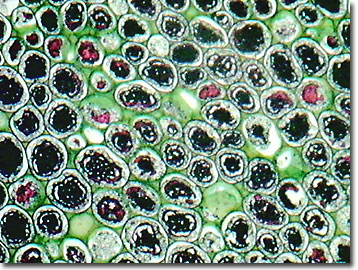Brightfield Digital Image Gallery
Bracken Fern (Pteridium) Rhizomes
As a monotypic genus of ferns in the phylum Filicophyta, Pteridium is only represented by P. aquilinum, known also as false indusium or the bracken fern. Unusual for most plant species, the bracken fern is considered to have a worldwide distribution (except in cold deserts) with possibly only two subspecies.

The bracken fern is useful as an indicator of the seral forest communities (and of the degree of disturbance), but is rarely found in forests older than 200 years. As new fronds unfurl in June (in Montana), wapiti (elk) feed on bracken ferns just as in New Jersey, white-tailed deer feast on the fiddleheads of ferns, but ignore mature plants. Only goats are known to graze on Pteridium at all of the plant's life stages, although some cattle use bracken fern as roughage when feeding on lush grass stands. When damaged, the fern fronds release hydrogen cyanide gas, and some herbivores, notably sheep, can selectively pick young fronds that are acyanogenic (without cyanide). Despite production of numerous bitter-tasting compounds that interfere with insect growth, a relatively large number of herbivorous insects eat bracken ferns.
Often considered a pest or nuisance species by ranchers and wildlife managers, bracken fern was considered so valuable during the Middle Ages that it was used as a medium of monetary exchange. Bracken ferns were employed as roofing material, used as a source of fuel for a quick, hot fire, acted as a source of potash for the pre-1860 soap and glass industries, and were used for manufacturing bleach. Rhizome extracts dyed wool yellow and tanned leathers. In Wales, bracken fern is still utilized as winter livestock bedding since it is warmer and easier to handle than straw. Native Americans peeled the starchy fiber of the bracken fern rhizomes into flour, while in Japan, confections are created from the rhizome starch. Raw rhizomes were consumed by Native Americans as a remedy for bronchitis, and a powdered form prescribed against parasitic worms. Additionally, the bracken fern is commercially grown for use as a food and herbal remedy in Japan, Canada, the United States, Siberia, China, and Brazil. Both fronds and rhizomes of bracken ferns have been used in brewing beer, and the starch sometimes substitutes for arrowroot. Picked in the spring, fiddleheads are consumed fresh or preserved by salting, pickling, or sun drying.
Contributing Authors
Cynthia D. Kelly, Thomas J. Fellers and Michael W. Davidson - National High Magnetic Field Laboratory, 1800 East Paul Dirac Dr., The Florida State University, Tallahassee, Florida, 32310.
BACK TO THE BRIGHTFIELD IMAGE GALLERY
BACK TO THE DIGITAL IMAGE GALLERIES
Questions or comments? Send us an email.
© 1995-2025 by Michael W. Davidson and The Florida State University. All Rights Reserved. No images, graphics, software, scripts, or applets may be reproduced or used in any manner without permission from the copyright holders. Use of this website means you agree to all of the Legal Terms and Conditions set forth by the owners.
This website is maintained by our
Graphics & Web Programming Team
in collaboration with Optical Microscopy at the
National High Magnetic Field Laboratory.
Last Modification Friday, Nov 13, 2015 at 01:19 PM
Access Count Since September 17, 2002: 16872
Visit the website of our partner in introductory microscopy education:
|
|
